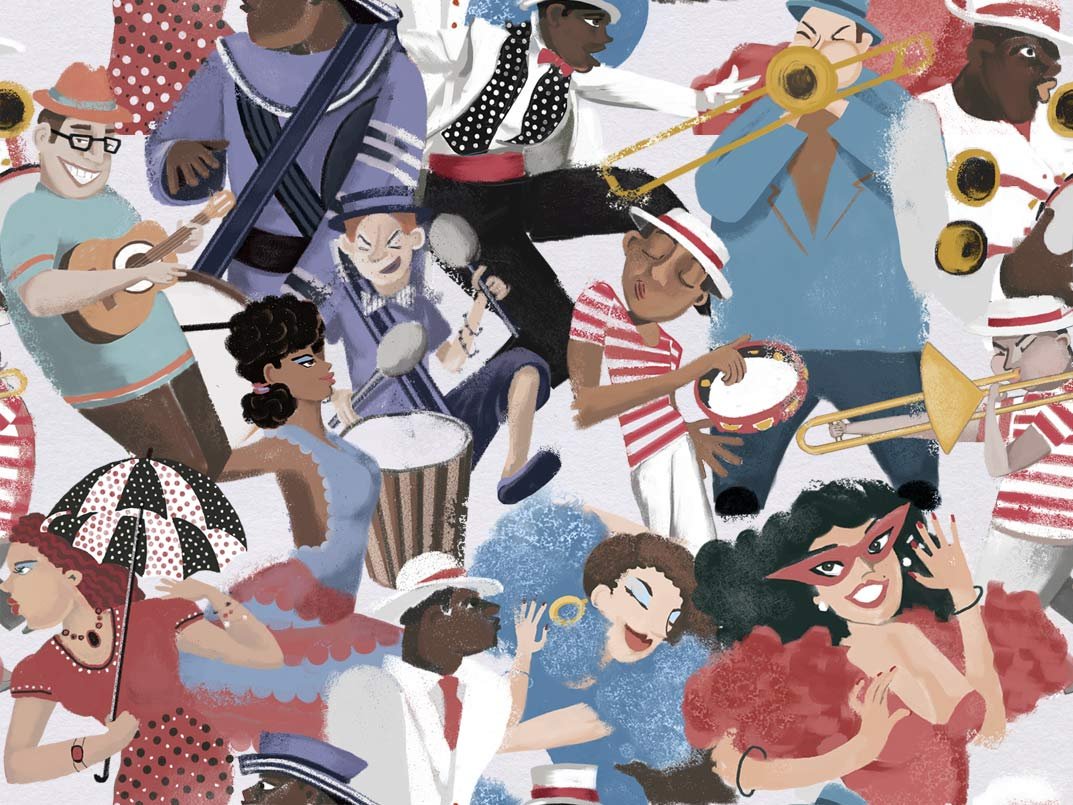
What People Are Saying
“Best Public Bash”
— Richard West
Texas Monthly, June 1980
The pre-Lent festival is an all-consuming party, complete with outrageous costumes and non-stop dancing. It is not a night for the timid or introverted, although the anonymity provided by costuming frees even the most inhibited souls to celebrate with complete abandon.
…Carnaval’s uninhibited atmosphere allows partygoers to witness and take part in what one regular calls “a festival of flesh” as the Mardi Gras-type event brings out the wildly dressed and the barely dressed for hours of energetic dancing to the seething samba beat.”
—Michael Point
Austin American-Statesman, 2/9/91
“Marlin Perkins of Wild Kingdom fame never saw as many animals as danced the samba, whooped, jumped up and down and just generally went bananas Saturday night at Carnaval Brasileiro, Austin’s annual answer to Brazilian Mardi Gras.
We are speaking of just one species of beast, though. Or, as they say in Rome, “partius animalaroonus.” An estimated 3,300 of these friendly critters jammed the City Coliseum for non-stop dancing to sensual, pounding Brazilian music played by a band called Carnaval Knowledge.
…It was kind of like the Cotton-Eyed Joe on steroids…The costumes at this bash, as usual, were fit for a Fellini movie. One guy who didn’t volunteer his name showed up in an outfit that sported a pair of fabric female breasts. Just who the heck did he think he was?
“I’m the whore of Babylon,” he said of his gear, which included an odd crown decorated, in part, by a couple of synthetic, curling ram horns. “It’s Carnaval, the festival of the flesh. Where else would the whore of Babylon be?”
A rather large fellow with a mustache sambaed the night away in a lime-green gown with huge hoops that made the outfit about 2 1/2 yards wide. He had a basket of white flowers on his head. Some of the female outfits were rather skimpy. A woman danced in front of the stage in a teddy. And later in the evening, she managed to make it onto the stage with the band.
Everybody seemed to have a good time. “That’s why I live in Austin, to go to things like this,” said Jackie Soliz, who was wearing a 1920s flapper outfit. “Don’t they have them all the time?”
—John Kelso
Austin American-Statesman, 2/10/86
“Forget New Year’s Eve, Halloween, the Fourth of July and even your birthday. Austin’s biggest party of the year rolls around again Saturday night at the City Coliseum. Yes, it’s Carnaval time. You poor souls who have not yet experienced this frenzied night of revelry owe it to your libidos to show up…
When [last year’s Carnaval] was finally over, I, like many other people, stood around in an exhausted daze–not unlike the afterglow of an orgasm–refusing to believe that such a high-level experience could ever end.”
— Dan Rice
The Daily Texan, 2/14/83
“Brazil Nuts Dept: I keep trying to think of reasons to disapprove of the city’s annual salute to bacchanalia, Carnaval Brasileiro, but I just can’t. After all, when you consider the capacity for magnum-force sensory overload engendered by thundering Latin percussion, sinuous lines of snake dancers, revelers in gaudy costumes or various stages of undress and ice-cold beer (often Brazilian Brahma), what’s not to like? Celebrating Carnaval is a hedonistic and riotously pagan job, but somebody’s got to do it.”
— John T. Davis
Austin Weekly, 2/6/92
Austin isn’t really Texas.
Despite being the state capital, this city of 680,000 has long had a slightly out-of-state sophistication, mixing international draws like the South by Southwest music and media festivals with some of the best barbecue anywhere. But for one night each winter, Austin goes even farther, channeling Brazil in what has become an over-the-top seasonal tradition. As it celebrates what organizers are calling its 30th anniversary on Feb. 3 at the Palmer Events Center, Austin’s Carnaval Brasileiro promises to once again shake off the blahs, bringing samba bands and giant puppets together with scantily clad revelers who, for one long, tune-filled night, trade their cowboy boots and jeans for beads, bangles, and feathers.
The music, Quinn says, is why he keeps the event going, and he proselytizes about it at every opportunity. For the throngs dancing, it’s less science than art and less art than just plain fun. “Initially, people go for the party,” he says. “But once they’re there, the music becomes a big part of it.”
Well, for some, perhaps. Regulars, several of whom maintain fan websites, spend almost as much time discussing their costumes and plans for future get-ups. What they don’t talk about are any of the usual disruptions newcomers might expect. Despite Carnaval’s ingredients–a large, dark hall filled with semi-naked participants, many of whom are drinking alcohol–the event courts and maintains a peaceful vibe.
Ample security helps, but the overall atmosphere is one of fun. An all-ages admission policy doesn’t keep Carnaval from being loud, crowded, and late. The biggest hassle I encountered was being cut off by an enormously long conga line. My husband and I waved at each other and tried to cut in. We ended up joining the line, running as much as dancing as it wove through the room. Maybe that was the point after all.
—Clea Simon
The Boston Globe, 1/7/2007
